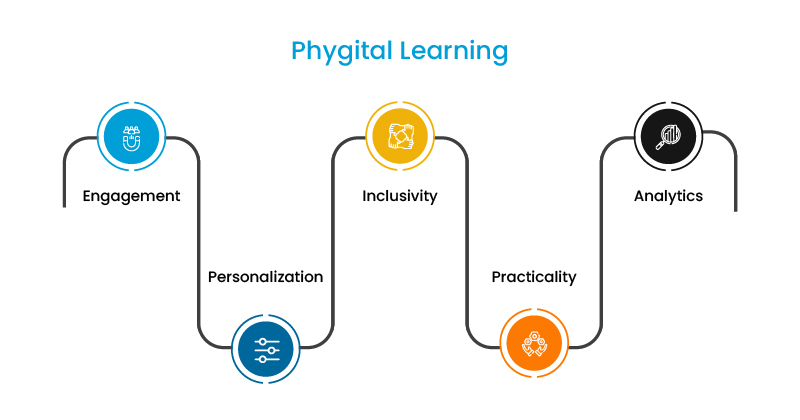PHYGITAL Learning: How is it bridging the digital divide?
This article introduces an intriguing concept involving the potential of ‘phygital learning environments’ to enhance students’ learning experiences beyond what can be achieved through purely physical or digital methods.
‘Phygital learning’ is a fresh pedagogical concept that aims to introduce a whole new dimension of learning, where students engage with their physical surroundings while digital information simultaneously elevates their competence levels.
In this blog series, we will also provide a conceptual framework for phygital learning, showing how it can be put into practical use. This innovative ‘phygital’ approach can enhance learning outcomes in the context of 21st-century technology. It achieves this with cutting-edge digital learning platforms that bridge the gap between classroom learning and outside-the-class learning.
The Möbius platform, by DigitalEd India, offers a seamless and intuitive phygital learning ecosystem for STEM education:
- Create interactive digital STEM courses
- Share multimedia content across the globe
- Leverage digital assessment pathways
- Offer individualized instructions to each student
- Identify and bridge knowledge gaps with in-depth insights
But what is phygital learning? Let’s discuss.
Phygital Learning – An Overview
Phygital learning, a term formed by blending “physical” and “digital,” signifies the seamless blend of face-to-face interactions and digital experiences in the world of education. It transcends the confines of traditional classroom teaching by embracing digital tools like online simulations, virtual reality (VR) adventures, interactive applications, and collaborative online platforms. The aim is to construct an interactive learning space that accommodates different learning preferences while harnessing the benefits of both physical and digital teaching techniques.
In simpler terms, phygital learning merges the best of the real world and the digital world to make education more engaging and effective. By doing this, it ensures that students with different learning styles can thrive while experiencing the advantages of both traditional and digital education.
Now let’s discuss the advantages of phygital learning.

- Enhanced Engagement: Phygital learning grabs students’ attention by making learning interactive and immersive. For example, history lessons can come alive with virtual reality visits to historical sites, or science experiments can be done through virtual simulations. This keeps students more interested and eager to learn.
- Personalized Learning: Digital tools empower educators to create customized learning experiences for each student. Adaptive learning systems analyze a student’s progress and offer content tailored to their specific needs. This way, students can learn at their own speed and focus on areas that need more attention.
- Accessibility and Inclusivity: Phygital learning breaks down geographical barriers. Students from different parts of the world can join the same virtual class, encouraging cultural exchange and diverse perspectives. It also benefits students with different abilities by providing adaptable learning materials.
- Real-world Application: By integrating digital resources, students acquire practical skills that are relevant in today’s digital age. They learn to navigate online platforms, critically assess digital information, and collaborate from a distance – all vital skills for the modern workforce.
- Data-Driven Insights: Digital tools collect valuable data about how students learn and perform. Educators can use this data to make informed decisions, pinpoint areas for improvement, and offer tailored support to students. This ensures a more effective and personalized learning experience.
The Future of Education: Embracing Phygital Learning Pathways
In the rapidly changing landscape of education, it is important to recognize that technology is not just a passing trend but a fundamental force that is reshaping the way we learn. As technology continues to advance, the lines between traditional in-person learning and digital education are becoming increasingly blurred. However, it is crucial to strike a balance to ensure that the human element in education remains intact. Educators will need to transition from being mere providers of information to becoming facilitators of meaningful learning experiences.
In conclusion, the integration of physical and digital elements in education represents a new era of learning. It offers the potential for interactive, personalized, and universally accessible education. As we navigate this exciting transformation, it is essential to remember that effective education is not solely determined by the tools we utilize but by our ability to empower students to explore, learn, and thrive.